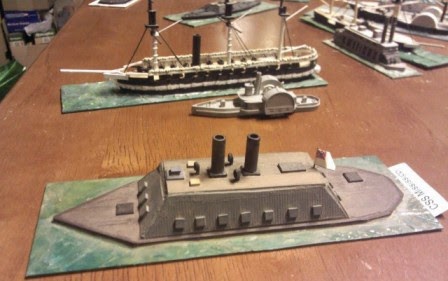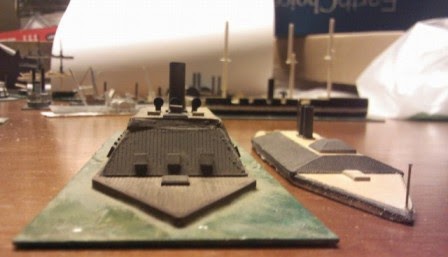Years ago, before the glorious golden age that Civil War naval games now enjoy, finding some of the more offbeat ship models was a challenge. So much so that we were reduced to having to scratch build some stuff to have a tabletop model. Reaching back into the archives I found one such project - one of my early attempts to model the never completed ironclad CSS Mississippi.
I started with some rough text descriptions - similar to CSS Louisiana, simple construction, two funnels. Now I had a model of CSS Louisiana from
Thoroughbred Figures, so that became the benchmark of the project.
Sketching out some rough shapes gave me a workable hull form. I cut the rough shape from scored styrene. Around this I added strip styrene to give the shape of the wooden hull. Atop this, I added a casemate also cut from scored sheet styrene. The challenge was cutting the pieces correctly so that they assembled into a mostly square edged, sloped rectangular casemate. The result looked like this.
![]() |
| Ray's CSS Mississippi |
It's a little crude and dated. The stacks and hatches are styrene. The ventilators were salvaged from a Sassacus kit that had been sacrificed to the parts bin. The upper deck of the casemate does not quite join with the port side of the casemate wall, but otherwise, it gives the impression of a large ponderous ironclad that would have been CSS Mississippi.
As the years rolled by, my scratch built model was no longer alone on the market.
Bay Area Yards rolled out a growing product line that eventually included a model of CSS Mississippi.At some point I added this model to my collection. Research into ACW ships had advanced greatly (or else Stephen had done his homework) for this model differed greatly from my creation.
While the two models share some common traits - approximately the same length, two stacks and a armored pilot house, our execution of the ship varied greatly. Stephen had modeled a sleek, low ironclad that seemed to share more with CSS Atlanta than the Louisiana.
![]() |
| Ray's scratch build on the left, the Bay Area Yards model on the right. |
![]() |
| This beam on shot shows the dramatic difference in heights between the two models. |
![]() |
| The overhead shot shows the similar hull forms that still end up different. |
The
Bay Area Yardshull is likely a more accurate model, but I have a strong attachment to my model. I'll keep both in the collection, if only to remind myself of where my modeling skills were at back in the day.





